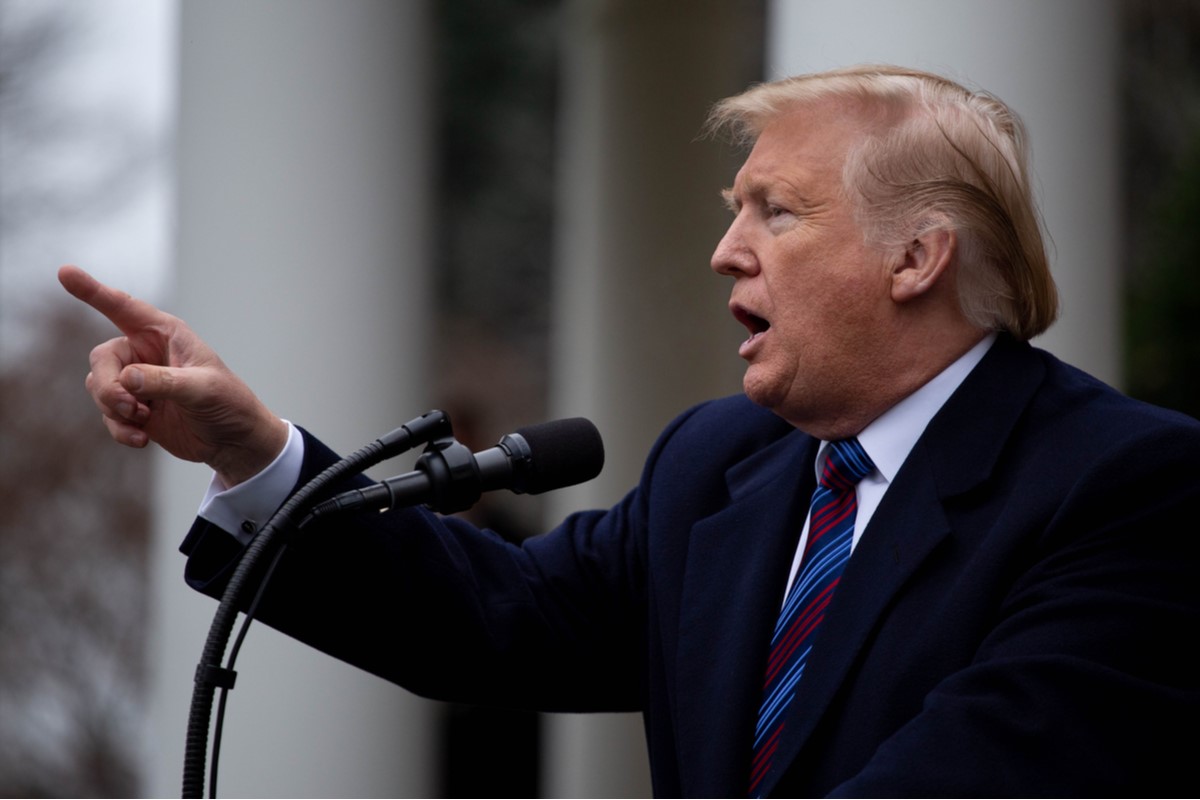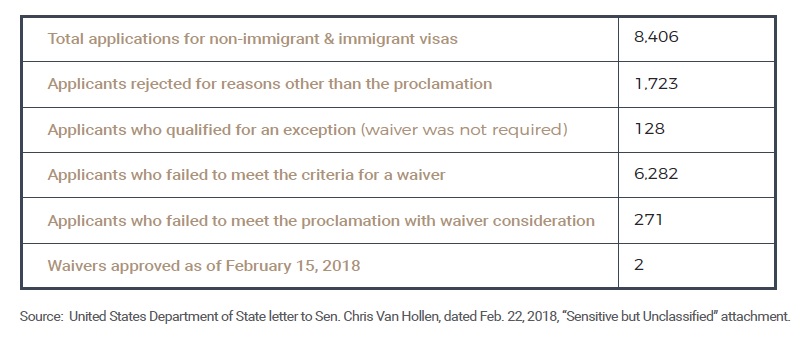
By Marjan Kasra and Babak Hojjat
Circumstances surrounding President Trump’s travel ban have been very fluid since its inception as “Travel Ban 1.0” on Jan. 27, 2017. Under said ban, Trump restricted entry into the United States for nationals of Iran, Iraq, Libya, Somalia, Sudan, Syria and Yemen. As a result, many from those countries were refused entry into the United States and many were restricted from boarding planes at airports worldwide.
Due to the fact that the citizens of these countries are predominantly Muslim, said ban was coined the “Muslim ban.” There was virtually no guidance on it from the Department of Homeland Security (DHS) to Customs and Border Protection (CBP), making for an extremely chaotic situation at U.S. ports of entries. Following days of protests and rallies at airports nationwide, a ruling by a Seattle federal judge blocked Travel Ban 1.0, allowing visas to be restored.
TRAVEL BAN EVOLUTION 1.0 TO 3.0
Following the failure of Travel Ban 1.0, the Trump administration came up with a watered-down version 2.0 on June 29, 2017. Before the ban even went into effect, opponents filed emergency motions in Hawaii. This time, in order to enter the country, the Trump administration said foreign nationals must prove a relationship with a parent, spouse, fiancé, child, adult son or daughter, son-in-law, daughter-in-law or sibling in the U.S. Other members of the family, such as grandparents, were initially excluded. The 2.0 version said they were not a “bona fide” relation to the foreign national. Following lawsuits, they were later included.
After a series of defeats, in June of 2017 the administration had a win at last. The U.S. Supreme Court, right before it took its summer recess, lifted the hold on the ban which had been in place by federal judges in both Hawaii and Maryland. The Supreme Court’s ruling was unsigned by liberal justices (Ruth Bader Ginsburg, Stephen Breyer, Sonia Sotomayor and Elena Kagan). Conservative Justices Neil Gorsuch, Clarence Thomas and Samuel Alito contended that the president’s administration should be permitted to enforce the ban in all instances. This effectively allowed the Trump administration to disallow citizens of Sudan, Syria, Yemen, Iran, Libya and Somalia from entering the U.S. for 90 days. It also barred nearly all refugees from coming into the U.S. for 120 days.
In an attempt to make the ban more of a permanent feature within the fabric of our immigration laws, on Sept. 24, 2017, the administration issued Presidential Proclamation 9645 (no longer titled “Executive Order”). It placed restrictions on eight countries: Syria, Venezuela, Yemen, Chad, Iran, Libya, North Korea and Somalia. It also placed added security measures on Iraqi citizens. Both the Ninth Circuit (Hawaii plaintiffs) and Fourth Circuit (Maryland plaintiffs) issued injunctions against this so-called “Travel Ban 3.0,” which again rendered Trump’s ban ineffective. However, on Dec. 7, 2017, this time the Supreme Court granted the administration’s motions for an emergency stay of preliminary injunctions.
As such, President Trump’s most recent travel ban went into effect on Dec. 8, 2017, for the predominantly Muslim countries while the appeals were still pending in both Ninth and Fourth circuit courts.
PRESIDENTIAL PROCLAMATION 9645
The Presidential proclamation, while narrower in its scope, is still considered by many to be motivated by animus and is unconstitutional on many levels. On its face, the proclamation claims to allow for a “waiver” process for people who pose no threat to United States. According to the proclamation itself, the Department of State was to provide “guidance” to the public. To date, there has been no clear guidance by the department. The only “guidance” is a virtual reiteration of the proclamation itself (See AILA Doc. No. 17120830). Although the Trump proclamation claims a “case-by-case” waiver is available to the adversely affected nationals, there has been virtually a categorical denial of affected parties since its implementation on Dec. 8, 2017. Visa applicants are provided with a generic denial notice, stating that they have been found “ineligible for a visa under Section 212(f) of the Immigration and Nationality Act, pursuant to Presidential Proclamation 9645. Today’s decision cannot be appealed.”
Following this generic denial, one of two boxes is checked off. The first option states that “taking into account the provisions of the proclamation, a waiver will not be granted” and that the applicant may reapply later in time. Said box appears to be checked for virtually all non-immigrant visas (if said non-immigrant visa is not one of the few “exceptions” under the proclamation) and also for all diversity visa applicants. The second box is generally checked for majority of immigrant visa applicants, including family-based and EB-5 visa categories. Here, the intending immigrant is advised that the consular officer is reviewing the applicant for a waiver under the proclamation, and further reference is made to the proclamation text. Said rejection notice ends by emphasizing that the waiver process is a lengthy one, and that the applicant remains “refused under Section 212(f).”
Section 3(c) of Proclamation 9645 grants authority to consular and immigration officials to grant waivers on a “case-by-case basis” to an individual who would otherwise be subject to the proclamation’s entry ban if: Denying entry would cause the foreign national undue hardship; entry would not pose a threat to the national security or public safety of the U.S., and entry would be in the national interest.
THE VISA WAIVER PROCESS
Although a waiver process is supposed to be possible, it is unclear as to what standards of proof are being used to make this determination.
Through a bipartisan letter written on Jan. 31, 2018, Sens. Jeff Flake and Chris Van Hollen requested information about visas from the State Department. In their letter, the senators assert that there have been reports of “uniform denial of waivers for visas.” Additionally, the senators emphasize that U.S. Department of State has not given the public any conclusive guidance on waivers and has not provided standards of proof or qualifications for granting waiver eligibility.
Following the letter, the U.S. Department of State responded by issuing a startling letter on Feb. 22, 2018 addressed to Sen. Van Hollen. The State Department revealed that: “Of the 8,406 applications for nonimmigrant and immigrant visas, only two waivers were granted as of Feb. 15, 2018.” In order to gain an understanding of how many individuals are adversely affected, one must review the Department of State’s Report of the Visa Office from 2017 (Department of State, Report of the Visa Office 2017, tbls XIV, XVIII). According to said State Department report, in 2016 alone, 73,500 visas were issued to the same nationals of the affected countries, which translates to an average of 6,125 visas per month. This number is now down to two over a span of time from Dec. 8, 2017 to Feb. 15, 2018.
According to the statistics as revealed by the letter addressed to Sen. Van Hollen, there appears to be an unprecedented denial rate of 99.9 percent as of Feb. 15, 2018.
Affected Applicant Statistics as per Department of State from December 8, 2017 to January 8, 2018, with rate of Approved Waivers through February 15, 2018.
 According to a more recent Senate letter from Senators Chris Van Hollen and Senator Chris Murphy to DOS dated April 19, 2018, it is the Senators’ understanding that the State Department had issued about 450 waivers as of the date of said letter. The senators requested (from DOS) “complete reports submitted by the Secretary of Homeland Security to the President every 180 days under Section 4 of PP9645 and any similar recommendation reports submitted prior to the announcement of PP 9645.” The Senators requested the guidance the State Department issued to U.S. Consular posts concerning implementation of the PP 9645 and the criteria used for evaluating waivers. Lastly, the Senators also requested detailed statistics, which include the total number of applicants (as of April 18, 2018) for nonimmigrant and immigrant visas, the number of applicants “refused under the proclamation with waiver consideration” and the total number of waivers approved.
According to a more recent Senate letter from Senators Chris Van Hollen and Senator Chris Murphy to DOS dated April 19, 2018, it is the Senators’ understanding that the State Department had issued about 450 waivers as of the date of said letter. The senators requested (from DOS) “complete reports submitted by the Secretary of Homeland Security to the President every 180 days under Section 4 of PP9645 and any similar recommendation reports submitted prior to the announcement of PP 9645.” The Senators requested the guidance the State Department issued to U.S. Consular posts concerning implementation of the PP 9645 and the criteria used for evaluating waivers. Lastly, the Senators also requested detailed statistics, which include the total number of applicants (as of April 18, 2018) for nonimmigrant and immigrant visas, the number of applicants “refused under the proclamation with waiver consideration” and the total number of waivers approved.
Of importance is that the senators in their April 19, 2018 letter point out inconsistencies with State Department’s reporting of actual approved waivers; as stated above, the State Department reported only two approved waivers as of February 15, 2018 by their letter dated February 22, 2018 to Senators Van Hollen and Flake. However, in a later interview less than two weeks later with Reuters, State Department asserted that they had issued “around 100 waivers.” Therefore, the senators have asked for more comprehensive, complete and accurate statistics from the State Department by April 30, 2018.
As the legal community anxiously awaits updated statistics from the State Department, we should bear in mind that even if there were 450 waiver approvals as of April 19, 2018, if we consider the rate of applicants to be similar to those from 2016, for a period of 4-5 months, we project the total number of applicants to be well over 20,000 individuals from the affected countries. Therefore the rate of individuals entering United States from the affected countries appear to hover around 1-3 percent. On April 10, 2018, Chad was taken off of the list of countries under Travel Ban 3.0 as it has “improved its identity-management and information sharing practices” according to White House press secretary Sarah Huckabee Sanders.
However, it is widely believed that the travel ban is discriminatory in nature, fueled by animus from Trump’s administration. Said animus has resulted in marginalization of a group of minorities, a majority of whom are Muslims. The arguments used by opponents of the travel ban at the appellate and Supreme Court levels allege violations of the Establishment Clause, Equal Protection Clause, Due Process Clause and Administrative Procedure Act.
In contrast to the long-standing U.S. visa program rules and regulations in place through INA and FAM, there is no requirement that applicants who are denied Section 3(c) waivers be advised of the reason for the denial. And unlike the visa program, there are no supervisory reviews or procedures to seek reconsideration. Furthermore, immigration practitioners are discovering that the intending immigrants are often not advised of the possibility that a waiver may be available to them. In fact, different visa applicants under identical circumstances are often treated differently at U.S. consular posts, in that some are advised that a waiver process is “available” to them, while others receive the 212(f) rejection where the first box is checked, indicating they are denied and no waiver is available. Therefore, the waiver process appears to be vague, ad hoc and subjective in nature. Oftentimes, the lawyers of represented applicants are given little or no feedback, other than parroting the language of the proclamation.
Given the DOS statistics as revealed by the letter to Sen. Van Hollen, any grant of waivers under Section 3(c) of the proclamation have been illusory at best. The provisions of the proclamation and lack of clear, objective guidance from Department of State sets our country back to the 1920s. Looking back at the Immigration Act of 1924, also called the National Origins Act and Asian Exclusion Act, it involved nationality-based allocations with the ultimate goal of reducing the number of non-whites. It targeted Asians, southern and eastern Europeans (especially Italians), Slavs and eastern European Jews. This was meant to “preserve the ideal of American homogeneity.” The act was abolished by President Johnson in 1965 when he signed into law the Immigration and Nationality Act, . While standing near the Statue of Liberty, he commented that “a very deep and painful flaw in the fabric of American justice” was being corrected.
The Supreme Court held hearings on Travel Ban 3.0 in April this year. As of print time, a decision is still to come. In April, the Trump administration also removed Chad from its list of restricted countries. The consensus within the legal community is that the court, in all likelihood, will resist making a merits-based determination of the travel ban. It is now within the court’s power to determine whether the judiciary will defer to the Executive Branch as the branch asserts its role in national security matters, regardless of a perceive animus in intent. That balancing act hangs the fate of millions of people who are from predominantly Muslim nations.
DISCLAIMER: The views expressed in this article are solely the views of the author and do not necessarily represent the views of the publisher, its employees. or its affiliates. The information found on this website is intended to be general information; it is not legal or financial advice. Specific legal or financial advice can only be given by a licensed professional with full knowledge of all the facts and circumstances of your particular situation. You should seek consultation with legal, immigration, and financial experts prior to participating in the EB-5 program Posting a question on this website does not create an attorney-client relationship. All questions you post will be available to the public; do not include confidential information in your question.







